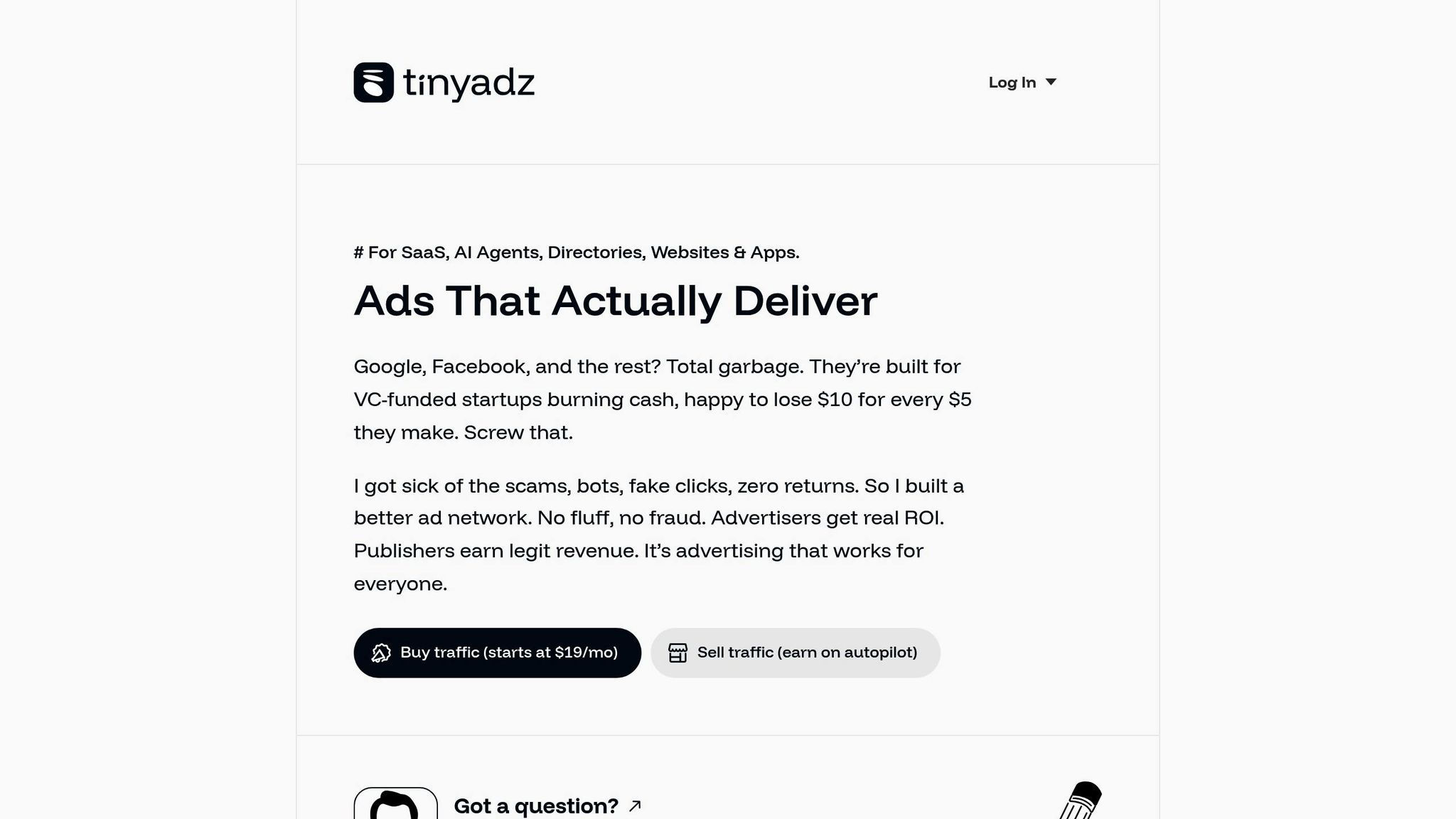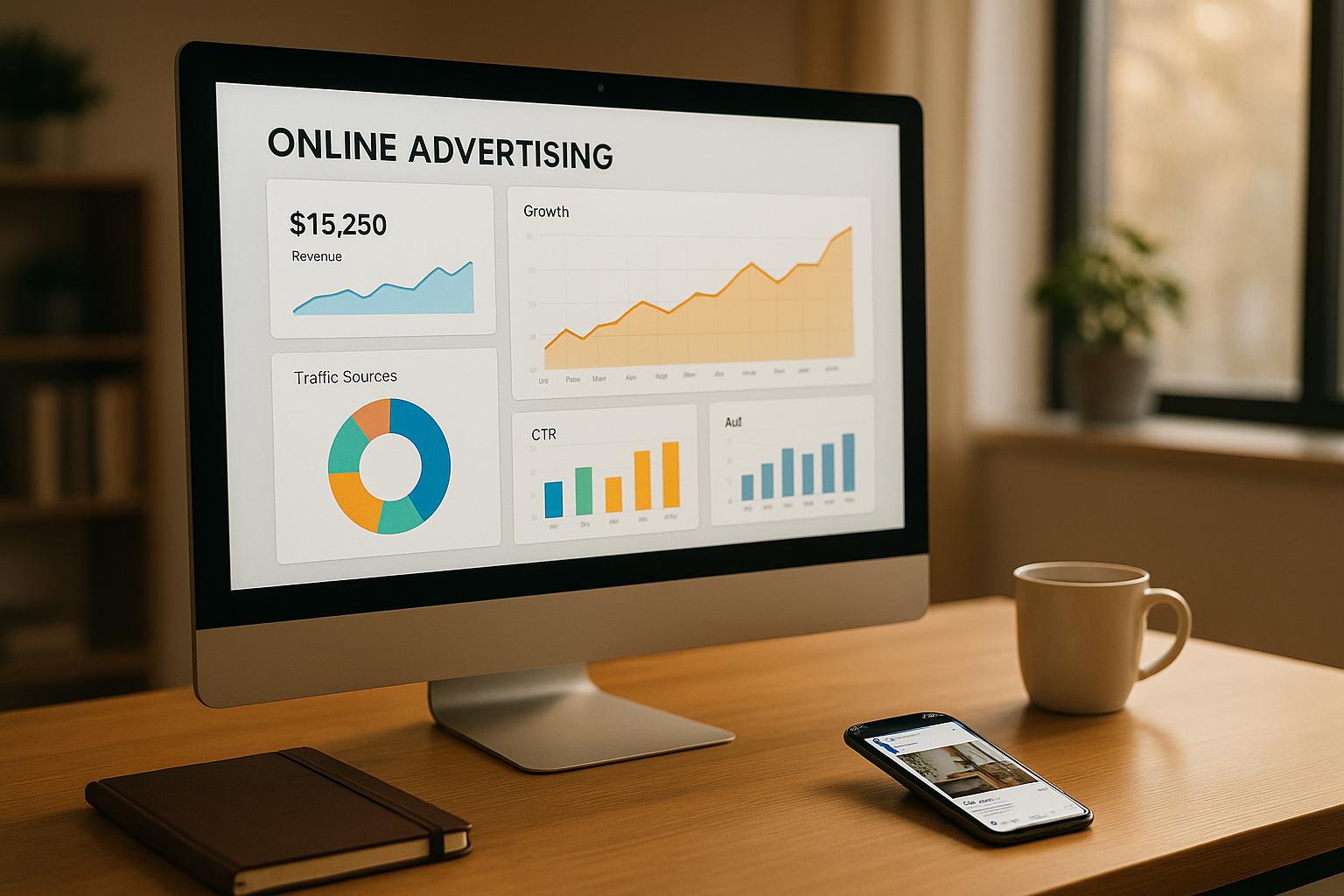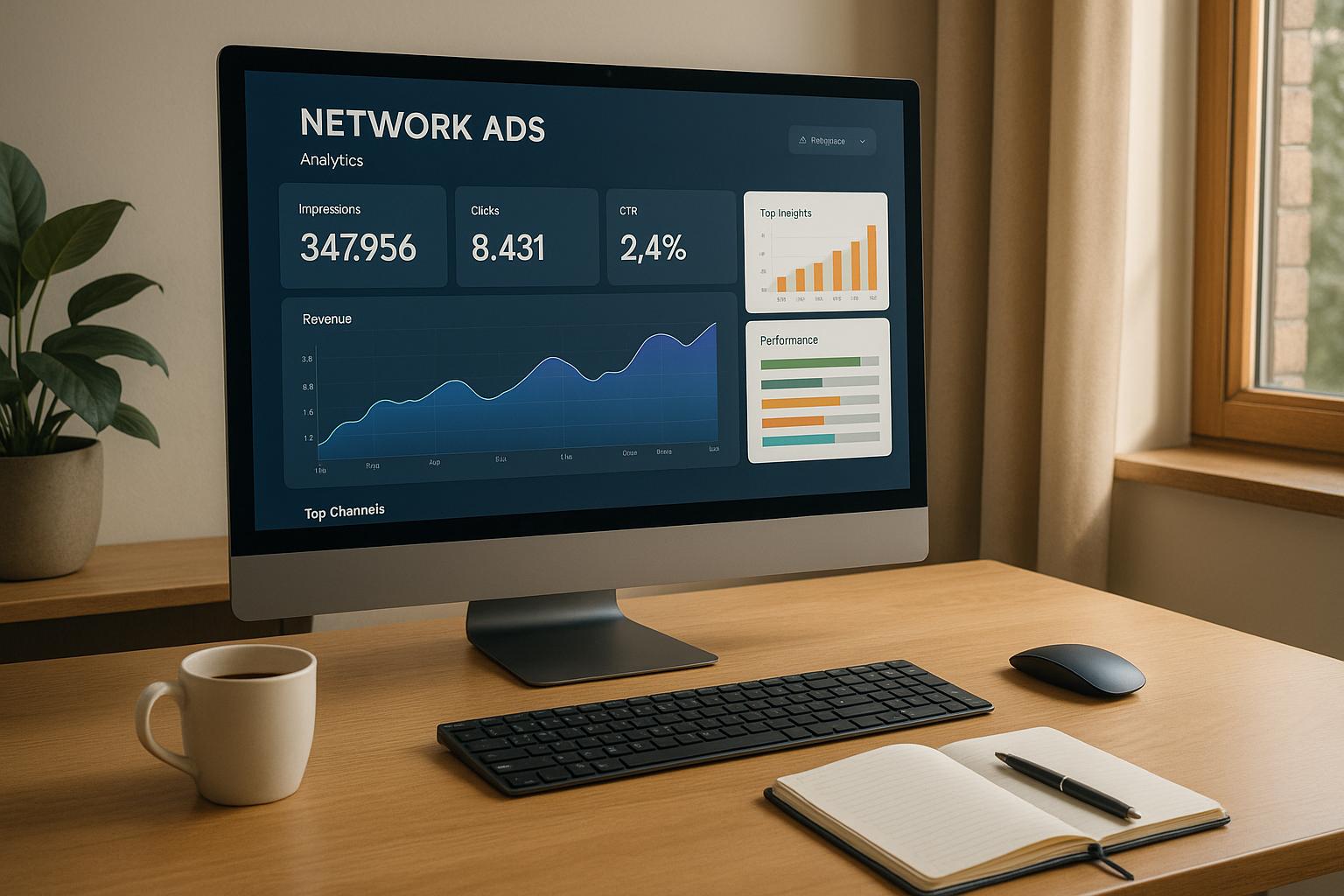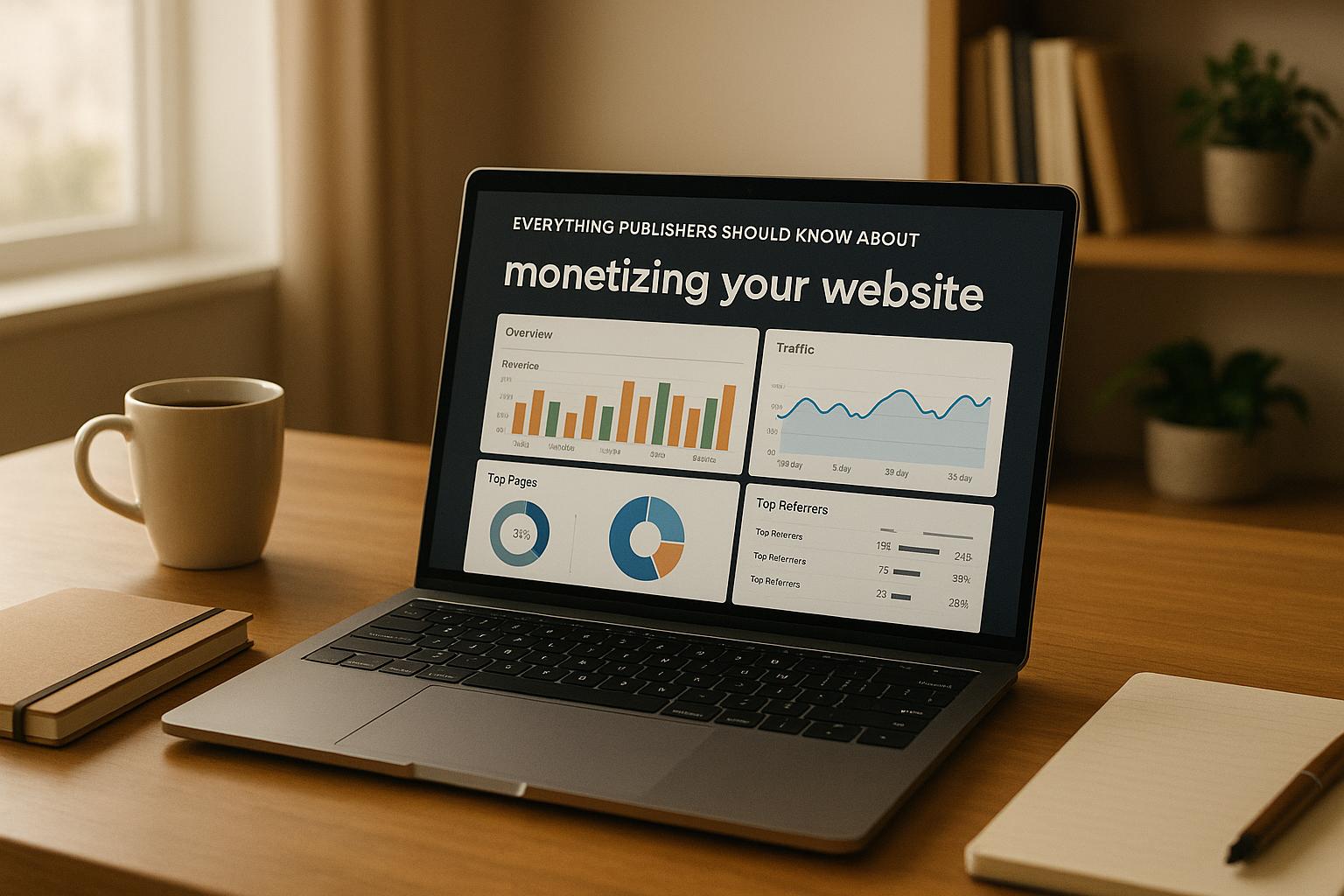Websites can earn anywhere from a few cents to thousands of dollars daily through ads, depending on factors like traffic, niche, and audience quality. Here's a quick breakdown of what you need to know:
-
Ad Revenue Models:
- CPM (Cost Per Mille): Earn per 1,000 ad views - ideal for high-traffic sites.
- CPC (Cost Per Click): Get paid when visitors click on ads - works best with engaged audiences.
- RPM (Revenue Per Mille): Your actual earnings per 1,000 views after revenue sharing.
-
Key Metrics to Track:
- Impressions: Total ad views.
- CTR (Click-Through Rate): Percentage of ad clicks vs. views.
- Viewability: Ads seen by users (50% visible for 1 second).
- Traffic Quality: Organic traffic often performs better than social traffic.
-
Revenue Benchmarks:
- Average CPM: $2.80 across industries.
- High-Value Niches: Finance and legal sites can see RPMs of $20–$50.
- Traffic Requirements: To earn $100/day with a $5 RPM, you'd need 20,000 daily page views.
-
How to Boost Ad Revenue:
- Optimize ad placement (e.g., within content, sticky ads).
- Target high-paying audiences (e.g., US visitors, specific demographics).
- Use tools like Google Analytics to track and improve performance.
Quick Example: A finance blog with 100,000 monthly visitors and a $25 RPM could earn $2,500/month.
Want to maximize your earnings? Focus on better ad placements, high-quality traffic, and consistent optimization.
How Much Ad Revenue Can a Website Make?
Ad Revenue Models and Key Metrics
Grasping how ad revenue models work is essential for boosting your earnings. Each model comes with its own payment structure and is tailored to specific types of websites and audiences.
Types of Ad Revenue Models
- CPM (Cost Per Mille): This model pays you for every 1,000 ad impressions. Since earnings are tied to how often ads are viewed, CPM is a great fit for high-traffic websites and campaigns focused on building brand awareness.
- CPC (Cost Per Click): With CPC, you earn money only when a visitor clicks on an ad. This model works best if your audience is highly engaged and your content encourages interaction with ads.
- eCPM (Effective CPM): This is a calculated metric that helps you compare earnings across different revenue models. It shows how much you would earn per 1,000 impressions, whether you’re using CPM, CPC, or another method.
- RPM (Revenue Per Mille): RPM reflects your actual earnings per 1,000 impressions after revenue sharing with ad networks.
Here’s a quick comparison of these models:
| Revenue Model | Payment Trigger | Best For | Revenue Predictability |
|---|---|---|---|
| CPM | 1,000 ad views | High-traffic sites, brand awareness | High – depends on traffic volume |
| CPC | Each ad click | Engaged audiences, niche content | Variable – influenced by click rates |
| eCPM | Calculated metric | Comparing performance across models | N/A – measurement tool |
Important Ad Performance Numbers
Choosing the right revenue model is just the beginning. Tracking key performance metrics is vital to maximize your earnings.
- Impressions: This counts how often ads are displayed. Higher traffic and smart ad placement can significantly boost impressions.
- CTR (Click-Through Rate): CTR measures how many people click on an ad compared to how many see it. It’s a strong indicator of ad relevance and placement, though rates can vary based on industry and positioning.
- Viewability: An ad is considered "viewable" if at least 50% of it is visible on-screen for one second. Viewability is crucial because low rates directly cut into your revenue. In the first half of 2022, the global viewability rate for desktop display ads was 71.5%.
- Fill Rate: This metric shows the percentage of ad spaces that are successfully filled with paid ads. A high fill rate means fewer missed revenue opportunities, while a low rate could indicate inefficiencies.
- Invalid Traffic (IVT): This includes non-human interactions like bot visits or fraudulent clicks. High IVT levels can result in penalties from ad networks and reduced earnings, so it’s wise to monitor this metric monthly.
- Bounce Rate: A high bounce rate, where visitors leave after viewing just one page, might point to poor ad placement or content that doesn’t engage users.
Daily tracking of metrics like Pageview CPM can help you spot trends and address issues early.
With mobile ad revenue already accounting for over 65% of digital ad spending - and expected to hit 70% by 2026 - optimizing your site for mobile users is no longer optional.
What Affects Your Ad Revenue
Several factors play a role in determining how much money your website can generate from ads. By understanding these elements, you can make smarter decisions to improve your site’s revenue potential. Let’s dive into how traffic, audience alignment, and ad placements impact your earnings.
Website Traffic and Visitor Details
Traffic volume is the backbone of ad revenue. Simply put, the more visitors your site attracts, the more ad impressions you generate - and with that, your earning potential grows. As noted by Aditude:
"Your website's traffic directly affects ad revenue. More visitors generally result in more ad impressions, leading to higher revenue." - Aditude
Here’s an example: If your RPM (Revenue per Mille) is $2.75, you’d need roughly 36,360 visitors daily to make $100. With an RPM of $4.50, that number drops to 22,220 visitors per day. At $6.10 RPM, you’d only need 16,390 daily visitors to hit the same $100 target.
But it’s not just about quantity - traffic quality matters just as much. Organic search traffic tends to outperform social media traffic when it comes to conversions. Publishers who prioritize growing their organic traffic often see quicker progress toward their revenue goals compared to those relying heavily on social platforms.
Visitor demographics also play a big role. Advertisers pay more for specific audience segments based on factors like age, gender, income, location, and interests. For instance, in 2024, targeted ads achieved a 17% higher click-through rate than generic ads, while behavior-based personalized ads converted nearly twice as well as non-targeted ads.
Geography is another key factor. Visitors from regions with higher purchasing power typically generate better revenue per impression. Additionally, understanding your audience’s browsing habits, device preferences, and content consumption patterns can help you fine-tune your ad placements and formats for better results.
Website Topic and Audience Match
Your site’s niche and content focus also have a direct impact on ad revenue. When your content aligns with what advertisers are looking for, competition for ad space increases, driving up rates. A well-defined, engaged audience in a specific niche often earns more than a broad, general audience.
Content relevance is equally important. Ads that match your audience’s interests naturally perform better. Publishers who focus on specialized content in high-value areas often attract advertisers willing to pay premium rates. This approach is more effective than simply chasing large volumes of random traffic.
Ad Position and Type
Strategic ad placement is one of the most effective ways to boost revenue, with 49% of publishers reporting success using this method. Placing ads thoughtfully ensures a balance between earning potential and user experience.
Ad visibility is critical. Prime positions include between paragraphs, near images, or as sticky ads. However, 86% of users report experiencing banner blindness, which highlights the importance of careful placement to catch attention without being intrusive.
Ad format also influences performance. Different formats work better for specific audiences and locations on your site. Experimenting with various ad sizes and placements can help you find the best combination.
Don’t overlook mobile optimization. Using responsive ad units and mobile-friendly formats ensures your ads perform well across devices.
User experience matters, too. Overly intrusive ads can hurt both your visitors’ experience and your SEO rankings. For instance, the average click-through rate on Google Ads is 3.17%, but this varies based on placement quality and overall site usability.
Technical tweaks, like lazy loading, can improve page speed and boost ad viewability. Using multi-size ad placements increases competition among advertisers, reducing unfilled ad slots. Additionally, features like ad refreshes and sticky ads can enhance visibility without disrupting the user experience.
To refine your ad strategy, analyze user behavior with tools like Google Analytics, heatmaps, and click tracking. These insights reveal where visitors focus their attention and how they interact with your site, helping you optimize ad layouts for maximum impact.
Industry Standards and Expected Earnings
Understanding typical earnings can help you set realistic goals for your website. Ad revenue varies widely depending on your site's niche, the quality of its traffic, and the demographics of your audience.
Average CPM and CPC Rates by Topic
The topic of your website plays a huge role in determining advertising rates. For instance, finance and legal services often dominate with higher rates, while e-commerce and travel sites might see lower rates but benefit from higher traffic volume.
Data from WordStream highlights what publishers can expect across various industries:
| Industry | Average CPC (Search) | Average CPC (Display) | Average CTR (Search) | Average CTR (Display) |
|---|---|---|---|---|
| Finance & Insurance | $3.44 | $0.86 | 2.91% | 0.52% |
| Legal | $6.75 | $0.72 | 2.93% | 0.59% |
| Technology | $3.80 | $0.51 | 2.09% | 0.39% |
| Health & Medical | $2.62 | $0.63 | 3.27% | 0.59% |
| Real Estate | $2.37 | $0.75 | 3.71% | 1.08% |
| E-Commerce | $1.16 | $0.45 | 2.69% | 0.51% |
| Travel & Hospitality | $1.53 | $0.44 | 4.68% | 0.47% |
Legal services stand out with a search CPC of $6.75, while finance follows at $3.44. For display ads - the bread and butter for most publishers - the average CPM across all industries is about $2.80. However, high-value niches like finance can see RPMs between $20 and $50, while technology and real estate sites typically range from $15 to $40. Health and wellness sites average RPMs from $10 to $25.
Geographic location also plays a major role in ad rates. For example, LinkedIn Ads average $5.58 per click, while Twitter Ads are much lower at just $0.38.
By examining these benchmarks, you can align your content with higher-paying niches to boost your revenue potential.
Sample Revenue Calculations
Here’s a look at how traffic and RPM benchmarks translate into revenue:
Daily Traffic Requirements for $100/Day:
| RPM Rate | Daily Page Views Needed | Monthly Page Views | Estimated Monthly Revenue |
|---|---|---|---|
| $5 | 20,000 | 600,000 | $3,000 |
| $10 | 10,000 | 300,000 | $3,000 |
| $20 | 5,000 | 150,000 | $3,000 |
| $30 | 3,333 | 100,000 | $3,000 |
Real-World Revenue Examples:
- A finance blog with 100,000 monthly visitors and an RPM of $25 earns $2,500 per month. With 500,000 visitors, that scales to $12,500 per month or $150,000 annually.
- Technology sites, with RPMs ranging from $15 to $40, can earn $3,000 to $8,000 monthly on 200,000 page views. The exact earnings depend on factors like audience engagement and ad placement.
- E-commerce sites, with RPMs between $5 and $15, generate $1,500 to $4,500 monthly from 300,000 page views.
- Health and wellness sites, attracting 150,000 monthly visitors at an RPM of $15, bring in about $2,250 per month. This niche benefits from strong advertiser demand, given the wellness market’s valuation of $4.5 trillion.
These figures are based solely on display ad revenue. Many publishers increase their earnings by diversifying into other monetization strategies beyond traditional ad networks.
To estimate your potential revenue, use this formula:
(Monthly Page Views ÷ 1,000) × Your RPM = Estimated Monthly Revenue
Monitor your RPM over time to refine your projections, as it often fluctuates with changes in traffic quality and ongoing optimization efforts.
sbb-itb-957fd63
How to Increase Your Ad Revenue
Boosting your ad revenue isn't about luck - it's about smart strategies. By focusing on ad placement, audience targeting, and constant fine-tuning, publishers can see noticeable gains in their earnings within a few months. These methods build on the metrics and benchmarks discussed earlier, providing a solid foundation for growth.
Better Ad Placement and Page Design
Where you place your ads can make or break your revenue potential. In fact, a Digiday survey found that 49% of publishers consider ad placement their top strategy for increasing revenue. The trick is finding the sweet spot between visibility and user experience.
For starters, ads placed within your content often perform better because they naturally integrate into the reading flow. Ads above and below images are another effective option since readers tend to pause there. Sticky ad units, which stay visible as users scroll, can also boost impressions without being disruptive. On mobile, responsive and vertical ad units are particularly effective at improving viewability.
Here’s a real-world example: one publication reported up to a 75% increase in search impressions and a 15–18% rise in organic clicks after optimizing their ad placements.
Offering multi-sized ad placements can also help. This approach gives advertisers more flexibility, improving fill rates and often driving up CPMs. Another useful tactic is lazy loading, which ensures ads load only when needed. This reduces page load times - a critical factor, as even a 2-second delay can harm user satisfaction.
Interestingly, 54% of ad creatives go unnoticed. Using heatmap tools to study where users focus their attention, combined with traffic data from tools like Google Analytics, can help you make smarter placement decisions.
Once you’ve nailed down placement, the next step is targeting the right audience.
Focus on High-Paying Audiences
Not all traffic is created equal. To maximize revenue, it’s crucial to concentrate on high-paying audience segments.
Geographic targeting is a great starting point. Visitors from regions like the United States, Canada, and Western Europe typically command higher CPMs. Tailoring your content to appeal to these audiences can make a big difference.
Demographics also play a key role. For example, targeting the 25–54 age group or professionals in lucrative industries like finance, legal, and healthcare can significantly boost revenue. In fact, audience segmentation has been shown to drive up to a 760% increase in earnings. Additionally, research shows that 81% of consumers are more likely to engage with brands offering personalized experiences.
Social analytics can be a goldmine of insights. By studying audience behavior across platforms, you can identify which groups are most engaged and profitable. This data can then guide your content strategy, ensuring you’re creating material that resonates with your most valuable audience segments.
Monitor and Measure Performance
The only way to know what’s working is to track your performance metrics. Regular monitoring allows you to spot trends and refine your strategies.
Some key metrics to watch include page views, bounce rate, impressions, click-through rate (CTR), and cost per mille (CPM). For instance, the average CTR on Google Ads is 3.17%, while CPMs typically fall between $1.00 and $3.00. These benchmarks can help you gauge your performance.
Ad viewability is another important factor. In the first half of 2022, desktop display ads had a global viewability rate of 71.5%. Keeping an eye on your viewability rates and adjusting placements accordingly can further boost your revenue.
Tools like Google Analytics and Google Ad Manager are invaluable for analyzing traffic patterns and ad performance. A/B testing is another useful technique - it helps you determine which ad layouts and formats work best.
For high-traffic sites, reviewing performance weekly can reveal valuable insights, such as which content types generate the highest revenue per thousand views (RPM) or the best times of day for ad performance. Smaller sites may benefit from monthly reviews. Use this data to refine your strategy and keep optimizing over time.
The bottom line? Treat optimization as a continuous process. By leveraging data and staying adaptable, you can ensure steady growth in your ad revenue.
How TinyAdz Helps Publishers Make Money

Once you've fine-tuned your ad strategy, the next logical step is choosing a platform that can truly boost your revenue. TinyAdz is designed to do just that, offering quality and transparency while ensuring 100% human impressions. This means advertisers get real engagement, and publishers enjoy legitimate earnings. It’s a win-win for everyone involved.
Ways to Earn Money with TinyAdz
TinyAdz goes beyond the usual banner ads, giving publishers multiple ways to monetize their platforms. Whether it’s through websites, social media, newsletters, or events, there’s a revenue stream for everyone.
- Tailored Display Ads: These ads are optimized to drive higher click-through rates, translating into better earnings.
- Directory Monetization: Ideal for niche website owners running resource directories or listing platforms, offering premium ad rates for specialized audiences.
- Social Media Monetization: Turn your social following into a revenue source by partnering with advertisers who want to reach your engaged audience.
- Newsletter Revenue: Email subscribers often convert at higher rates, making newsletters a lucrative option.
- Event Monetization: If you host webinars, conferences, or other online events, you can command premium ad rates while engaging a highly targeted audience.
Advantages for US Publishers
For publishers in the US, TinyAdz offers some standout benefits. There’s no minimum traffic requirement, so even smaller sites can start earning right away. The platform’s personalized matchmaking system pairs you with advertisers who value your audience, ensuring campaigns are relevant and impactful.
Transparent reporting tools make it easy to track your earnings and refine your strategy. Plus, with a range of flexible ad formats, you can choose campaigns that fit your site’s aesthetic and maintain editorial independence. TinyAdz also understands the nuances of the US market, connecting publishers with brands that prioritize quality and engagement.
TinyAdz Feature Comparison
TinyAdz’s features align perfectly with strategic ad placements and precise audience targeting. Here’s a quick breakdown of what they offer:
| Feature | Best For | Key Benefits |
|---|---|---|
| Banner Ads | Bloggers, content sites, news publishers | Premium campaigns, audience-specific ads, flexible placement options |
| Directory Monetization | Resource sites, niche directories | Higher rates for targeted audiences, specialized advertising |
| Social Media Monetization | Influencers, creators | Monetize engaged followers, expand earnings beyond your website |
| Newsletter Revenue | Email publishers | High conversion rates, premium ad placements |
| Event Monetization | Webinar hosts, conference organizers | Premium rates, high-engagement opportunities |
Whether you’re a blogger, newsletter publisher, SaaS creator, or directory owner, TinyAdz has tools tailored to your monetization needs.
What truly sets TinyAdz apart is its focus on quality over quantity. Instead of overwhelming your site with low-paying ads, the platform connects you with advertisers who genuinely value your audience. This approach not only drives higher CPMs but also fosters long-term relationships with advertisers, leading to steady revenue growth over time.
Key Points for Publishers
To estimate your potential ad revenue, start by calculating your monthly pageviews and multiply that by your expected RPM (revenue per thousand impressions). For instance, finance websites often achieve RPMs ranging from $30 to $50, though this can vary depending on audience value and advertiser demand across different niches.
Where your audience is located matters too. Publishers targeting Tier 1 countries - like the USA, UK, Canada, and Australia - usually benefit from higher CPC and RPM rates. Did you know that over 60% of organic Google searches in the USA are done on mobile devices? This makes having a mobile-friendly ad strategy not just smart but essential. These insights tie directly into optimizing ad placements, which we’ll touch on later.
The world of digital advertising is changing fast. By 2025, digital ads are projected to account for 73% of a $1.08 trillion market, with programmatic bidding driving 96% of new display-ad dollars. Staying ahead of these trends could open the door to a share of the $725 billion expected in global programmatic ad spending by 2026.
To maximize your earnings, focus on above-the-fold and multisize ad placements. Multisize placements encourage competition among advertisers and improve fill rates, while lazy loading helps maintain site speed and ad viewability. Contextual advertising is another powerful tool - it’s been shown to extend user browsing time by about 25% and boost ad revenue by 15–20%.
Continuous testing and adjustment are crucial. Experiment with A/B testing for ad placements, formats, and targeting to see what works best. Keep an eye on key metrics like CTR, conversion rates, and ROAS to make data-driven decisions that improve performance.
Diversify your approach to strengthen your monetization strategy. Video content is now a must-have - 95% of businesses say it’s vital for marketing, and 93% report a strong ROI. Rewarded advertisements are also gaining traction and are expected to deliver a 30% revenue increase by 2025. Meanwhile, contextual targeting ensures ads align with relevant content, improving both user experience and ad performance.
Don’t overlook the challenge of ad blockers - 763.5 million internet users globally rely on them. Striking a balance between generating ad revenue and maintaining a seamless, trustworthy user experience is key. Publishers that prioritize high-quality content alongside thoughtful ad placement are better positioned to build strong, lasting relationships with their audience and advertisers.
To help publishers put these strategies into practice, TinyAdz offers a tailored solution. With no minimum traffic requirements and a personalized approach to connecting publishers with advertisers, TinyAdz helps publishers of all sizes optimize their earnings through quality-driven monetization strategies designed specifically for the US market.
FAQs
How do I choose the best ad revenue model for my website's audience and traffic?
Choosing the right ad revenue model hinges on understanding your website's traffic and how your audience interacts with content. If your site pulls in large volumes of traffic, a CPM (cost per mille) model - where earnings are based on ad impressions - might be the way to go. On the other hand, if your audience is highly engaged and likely to click on ads, a CPC (cost per click) model can bring in greater returns.
To make an informed choice, dive into metrics like traffic sources, audience demographics, and engagement levels. These details will help you decide whether targeted ads, programmatic advertising, or a combination of models suits your needs. Experiment with different strategies and compare the results to uncover the most effective approach for boosting your website’s revenue.
How can I attract high-quality traffic to boost my website's ad revenue?
To bring in high-quality traffic and boost your website's ad revenue, start by focusing on what your audience wants and needs. Craft content that’s not only engaging but also offers real value and aligns with their interests. When your content connects with your target audience, it naturally attracts more organic traffic.
On top of that, make sure you’re following SEO best practices. This includes using the right keywords, ensuring your site loads quickly, and building strong backlinks. Don’t forget to share your content on social media and through email campaigns to reach a wider, yet still relevant, audience.
Finally, never underestimate the power of a great user experience. A clean, intuitive design, easy navigation, and mobile-friendly pages can make all the difference in keeping visitors on your site and encouraging them to come back for more.
How does my website's niche affect ad revenue, and which niches are the most profitable?
Your website's niche is a key factor in shaping its ad revenue potential. Certain niches, such as finance, insurance, health, and real estate, often bring in higher earnings. Why? Advertisers in these industries are willing to pay top dollar to connect with their target audiences, which drives up CPC (cost per click) and RPM (revenue per thousand visitors) rates.
Websites that focus on a specific niche and attract an engaged audience tend to perform better with ads. Advertisers prioritize relevance and are drawn to platforms that deliver higher conversion rates. If you're deciding on a niche, areas like cryptocurrency, personal finance, health & fitness, and technology stand out as particularly profitable for ad monetization. Choosing a niche with strong advertiser interest can make a big difference in your earning potential.


